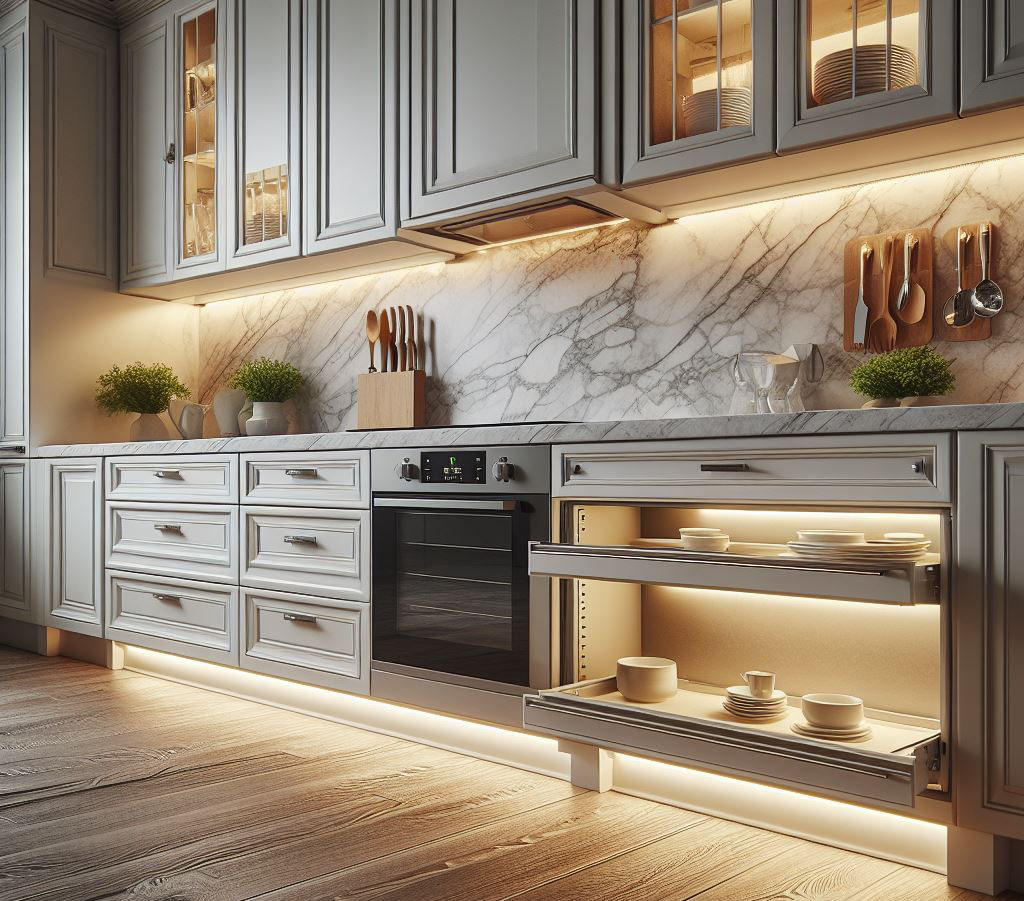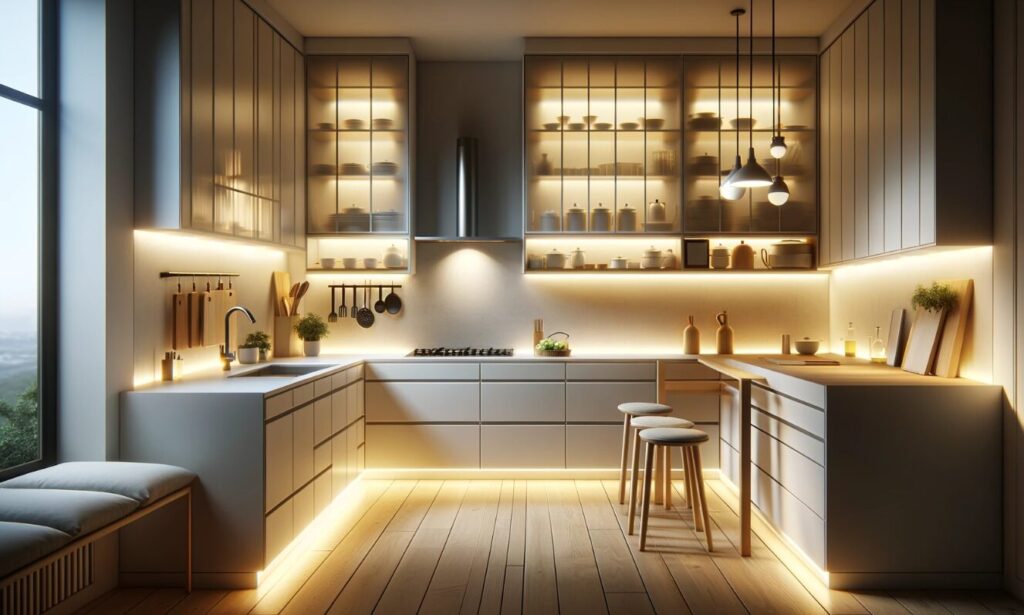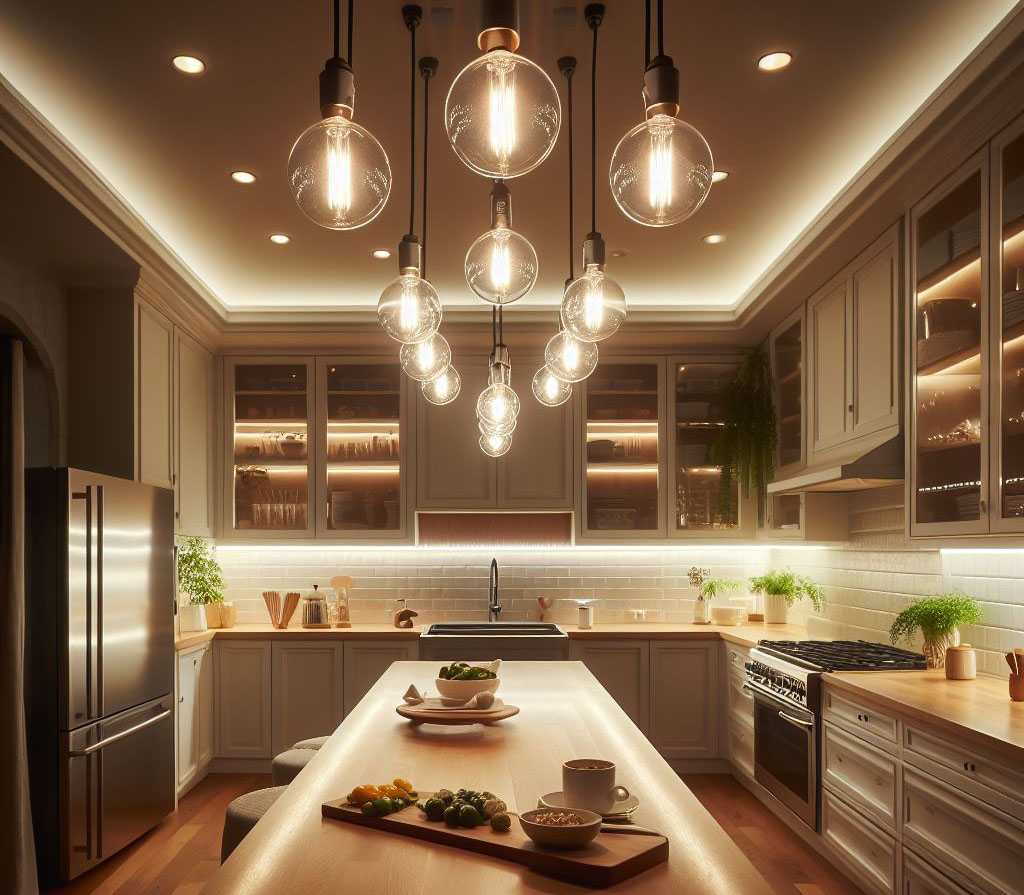In the realm of kitchen transformations, under-cabinet lighting is a subtle yet striking element that elevates both the functionality and aesthetics of your space. It’s not merely about positioning lights, it’s a thoughtful approach to enhancing your kitchen’s ambiance and utility. This type of lighting transcends mere decoration, it serves as a practical fixture that, when executed properly, can revolutionize the way you perceive and utilize your kitchen.
While primarily celebrated in kitchen settings for its ability to illuminate countertops and add depth to the space, under-cabinet lighting’s versatility extends beyond, enriching workspaces such as home offices, garages, and display areas with its subtle yet effective glow. This transformative tool is a testament to the power of well-considered lighting in interior spaces.

Understanding Under-Cabinet Lighting
At its core, under-cabinet lighting is about strategically placing light fixtures in overlooked spaces to illuminate the area beneath. These fixtures are more than aesthetic enhancements, they are functional assets that combat shadows and breathe life into countertops and workspaces.
Functionally, these lights serve a dual purpose: they set a warm, inviting ambiance while providing focused task lighting, ensuring that every chop and stir is done under the clarity of well-appointed lights. Though they shine in kitchens, casting a glow that accentuates the textures and tones of your culinary space, these lights are not confined to one room. They adapt to various settings, casting a glow on workbenches, enhancing the visibility in crafting areas, and adding a layer of warmth to living spaces.
Types of Under-Cabinet Lighting
Venturing into the world of under-cabinet lighting, you’re met with a spectrum of choices, each with its own merits. Let’s navigate through the most prevalent options:
- LEDs (Light Emitting Diodes): The frontrunners in the realm of energy-efficient and long-lasting lighting. LEDs are cool to the touch, making them a practical choice for areas where heat sensitivity is a concern. Their lifespan is commendable, ensuring that your space is illuminated for years to come. The range of color temperatures available allows you to tailor the ambiance of your space from bright and energizing to soft and soothing.
- Fluorescent Lights: Once the standard, these lights are known for their energy efficiency. However, they don’t quite measure up to LEDs in terms of lifespan. Their initial cost-saving benefit is balanced by the need for more frequent replacements compared to their LED counterparts.
- Halogen Lights: These are the traditionalists of under-cabinet lighting, known for their bright and vibrant illumination, perfect for accentuating the finest details of your countertop materials. However, their high heat output and energy consumption are significant considerations, especially in an age where energy efficiency and sustainability are paramount.
When selecting the ideal lighting for your space, consider your priorities: longevity, energy consumption, and the quality of light. LEDs stand out for their efficiency and lifespan, fluorescents offer an economical upfront cost, and halogens shine in their vibrancy and color accuracy. Remember, the right lighting is not just about illuminating a space, it’s about enhancing the way you live and work in that space.

Features to Consider
Embarking on the journey of selecting under-cabinet lighting isn’t just about picking fixtures, it’s about understanding the intricate details that contribute to the ambiance and functionality of your space. Let’s delve into the specifics:
- Brightness and Color Temperature: These fundamental elements set the stage in your kitchen. Brightness determines how much light is cast onto your work surfaces, directly influencing the functionality and comfort of your tasks. Color temperature shapes the mood, ranging from a warm, inviting glow to a bright, energizing radiance. Striking the right balance between the two can transform your kitchen from a mere cooking area to the vibrant heart of the home.
- Dimmability: This feature introduces versatility into your space. With dimmable lights, you have the control to adjust the intensity of your lighting based on the time of day or the task at hand, enhancing both the utility and the atmosphere of your kitchen. It’s also an economical choice, allowing for reduced energy consumption when full brightness isn’t necessary.
- Color Rendering Index (CRI): CRI measures the ability of light to reveal the true colors of objects faithfully. A high CRI is particularly significant in spaces like kitchens, where accurate color representation contributes to the aesthetics and the culinary experience. Opt for fixtures with a CRI of 90 or above to ensure your space is seen in its best light.
- Energy Efficiency: Selecting energy-efficient lighting is a responsibility in our eco-conscious world. LED options offer significant savings on energy bills while minimizing environmental impact. Their long lifespan and low heat emission make them a smart investment for any discerning homeowner.

Installation Tips
Whether you’re a seasoned DIY enthusiast or considering professional installation, the process of installing under-cabinet lighting requires careful thought and planning:
- DIY vs. Professional Installation: Assess your comfort level with electrical tasks. While DIY installation can be rewarding, ensuring safety and accuracy is paramount. If you’re not confident in your electrical skills, seeking professional help can provide peace of mind and guarantee a seamless finish.
- Basic Steps for Installing Different Types of Under-Cabinet Lighting:
- For Hardwired Lights: Embrace the process with precision and caution. Begin by ensuring the power is off, then proceed with meticulous measurements and secure installations. The goal is not only to add light but also to maintain the integrity and safety of your electrical system.
- For Plug-Ins: These offer a more straightforward installation process, ideal for those looking for a quick and efficient solution. Plan the layout carefully, ensuring that cords are neatly managed and the fixtures are placed for optimal lighting coverage.
- For Battery-Operated: The epitome of convenience, these lights can be installed with minimal fuss. However, it’s crucial to consider the placement and the frequency of battery changes to ensure consistent lighting without unwelcome interruptions.
- Tips on Positioning and Spacing for Optimal Illumination:
- Distribute the lights evenly to avoid uneven shadows and ensure a harmonious spread of light across your work surfaces.
- Angle the lights towards the backsplash to maximize the illumination on your countertops while minimizing glare and shadow.
- Measure the spacing between fixtures carefully. Appropriate spacing ensures a cohesive lighting effect, enhancing both the functionality and the aesthetic appeal of your space.

Top Picks for Under-Cabinet Lighting
Navigating through the myriad options for under-cabinet lighting can feel like charting through unmarked territory. Here, I’ve distilled the options down to the ones that have consistently proven their worth across numerous projects.
- LED Strip Lights: These have emerged as the frontrunners in the race for sleek, efficient under-cabinet lighting. They offer an unobtrusive, almost seamless lighting solution, boasting energy efficiency and an impressive lifespan. Be discerning in your selection, though, quality varies widely. Opt for a reputable brand to avoid color discrepancies and premature dimming.
- Battery-Operated LED Pucks: These offer a no-fuss solution for areas where wiring is a complex affair. Installation is a breeze—no wires, no drilling. However, it’s prudent to monitor battery life to prevent unexpected dim-outs. They’re a solid choice for temporary setups or as a stopgap, but may not be the long-haul solution for everyone.
- Wireless LED Systems: These represent the cutting edge of under-cabinet lighting. With features allowing control via remote or smartphone, they offer unparalleled convenience. However, their performance hinges on your home’s Wi-Fi reliability, so ensure your network is robust to avoid connectivity hiccups.
Maintenance and Safety
A well-maintained lighting system not only ensures longevity but also safety. Here’s how to keep your under-cabinet lights in top condition:
- Keep ‘Em Clean: Regular cleaning is paramount. Dust and grease accumulation can significantly diminish light output. A gentle wipe with a soft cloth usually suffices, but for fixtures near cooking areas, a mild degreaser might be necessary to cut through the kitchen’s inevitable film.
- Safety First: Electrical safety is non-negotiable. Always ensure the power is off before attempting any maintenance or adjustments. If electrical work seems daunting or if you’re uncertain about your lighting fixtures’ condition, don’t hesitate to consult a professional. It’s an investment in safety and peace of mind.
FAQ Section
The ideal choice varies depending on your kitchen’s dimensions, design, and your specific needs. LEDs are generally a versatile and efficient choice for a wide range of settings. For less permanent solutions or spaces where wiring poses a challenge, battery-operated or wireless options offer flexibility and ease.
Absolutely. Battery-operated options provide a simple, wire-free installation and are particularly suitable for areas where electrical access is limited. Keep in mind the ongoing need to replace batteries and consider the environmental impact of your choice.
Color temperature selection is pivotal in creating the desired ambiance. Warm whites (around 2700K) are conducive to a cozy, relaxing atmosphere, while cooler whites (3000K and above) impart a crisper, more alert vibe. Consider the primary function of your space and your personal preference to make an informed decision.
The difficulty level varies with the type of lighting and your own comfort with DIY projects. Plug-in and battery-operated lights are generally user-friendly. However, hardwired options might require a more nuanced approach and a solid understanding of home electrical systems. When in doubt, consulting a professional is a wise choice.
LEDs typically require minimal maintenance – a regular clean to keep them bright is usually sufficient. For other types like pucks or strips, periodic checks for connectivity and battery life can help maintain optimal performance. Regular attention ensures your under-cabinet lighting continues to enhance your space effectively.
